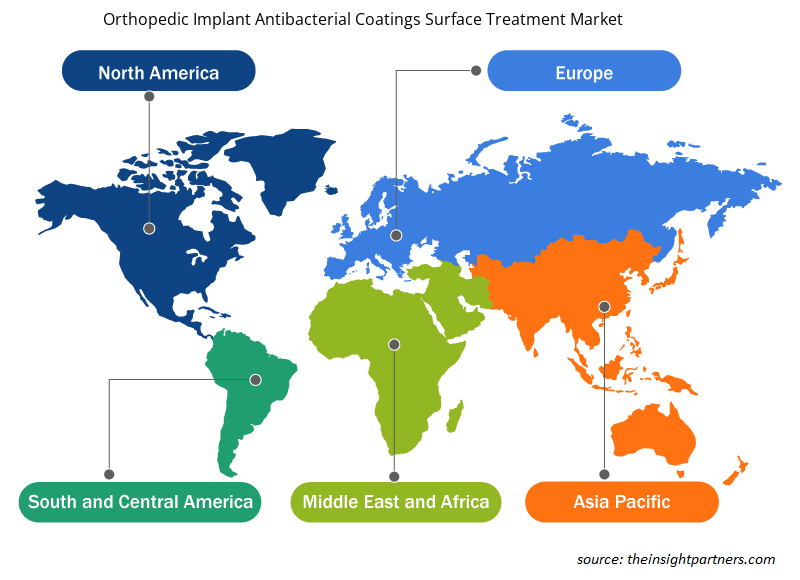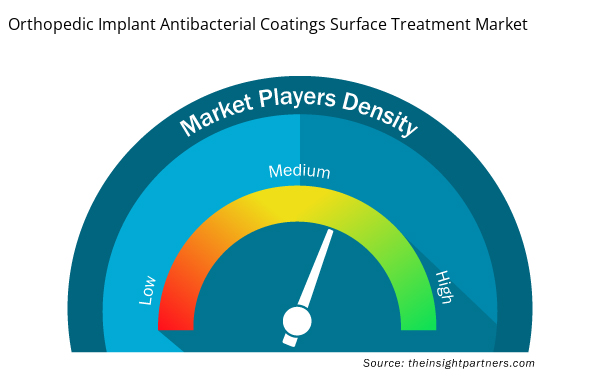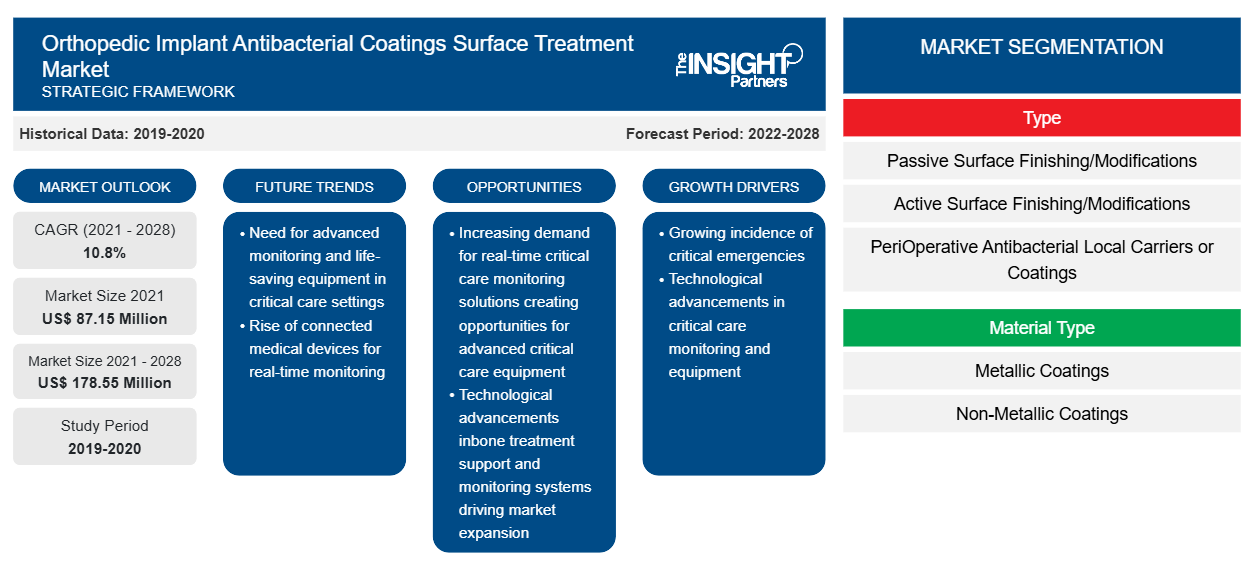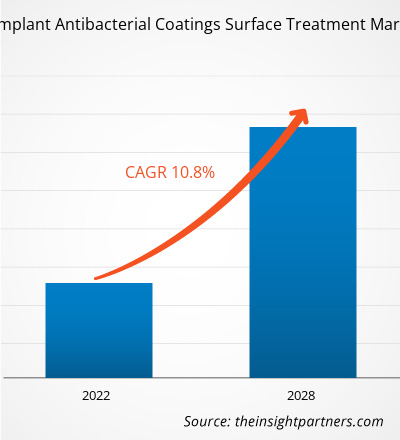Der Markt für antibakterielle Oberflächenbeschichtungen für orthopädische Implantate soll von 87,15 Millionen US-Dollar im Jahr 2021 auf 178,55 Millionen US-Dollar im Jahr 2028 anwachsen; für den Zeitraum von 2021 bis 2028 wird eine durchschnittliche jährliche Wachstumsrate (CAGR) von 10,8 % erwartet.
Bakterielle Infektionen und infektionsbedingte Immunreaktionen sind bei Patienten, die sich einer orthopädischen Implantatoperation unterziehen, zu einem lebensbedrohlichen Problem geworden. Die Biokontamination herkömmlicher Biomaterialien führt zu einer bakteriellen Invasion in verletzten Bereichen, was zu postoperativen Erkrankungen führt. Daher werden dringend infektions- und immunausweichende Beschichtungen für orthopädische Implantate benötigt. Die Nachfrage nach orthopädischen Implantaten wie Schrauben, Platten, Nägeln und künstlichen Gelenken steigt in Krankenhäusern für orthopädische Chirurgie. Darüber hinaus steigt die Nachfrage nach Beschichtungen der Implantate mit einem Anti-Biofouling-Polymer, das verhindert, dass Biosubstanzen und Bakterien an der Oberfläche haften bleiben.
Der Markt für antibakterielle Oberflächenbeschichtungen für orthopädische Implantate ist nach Typ, Materialtyp und Geografie segmentiert. Geografisch ist der Markt grob in Nordamerika, Europa, Asien-Pazifik, den Nahen Osten und Afrika sowie Süd- und Mittelamerika segmentiert. Der Bericht bietet Einblicke und eine eingehende Analyse des Marktes und betont Parameter wie Markttrends, technologische Fortschritte und Marktdynamik sowie die Analyse der Wettbewerbslandschaft der weltweit führenden Marktteilnehmer.
Passen Sie diesen Bericht Ihren Anforderungen an
Sie erhalten kostenlos individuelle Anpassungen an jedem Bericht, einschließlich Teilen dieses Berichts oder einer Analyse auf Länderebene, eines Excel-Datenpakets sowie tolle Angebote und Rabatte für Start-ups und Universitäten.
- Holen Sie sich die wichtigsten Markttrends aus diesem Bericht.Dieses KOSTENLOSE Beispiel umfasst eine Datenanalyse von Markttrends bis hin zu Schätzungen und Prognosen.
Markteinblicke
Anstieg der Prävalenz implantatbedingter Infektionen treibt Wachstum auf dem Markt für antibakterielle Oberflächenbeschichtungen für orthopädische Implantate voran
Implantatassoziierte Infektionen sind auf verschiedene Faktoren zurückzuführen, darunter antibakterielle Prophylaxe, Bakterienlast, Mikroorganismen- und Wirtstyp, chirurgisches Verfahren und Technik sowie Implantattyp. Die zunehmende Verbreitung implantatassoziierter Infektionen ist einer der Hauptfaktoren, die den Markt für antibakterielle Oberflächenbeschichtungen für orthopädische Implantate antreiben.
Laut einer Studie des Journal of Orthopaedic Surgery and Research aus dem Jahr 2018 beträgt die Prävalenz von implantatassoziierten Infektionen bei orthopädischen Traumapatienten 5 bis 10 %. Jedes Jahr werden in den USA 750.000 bis 1.000.000 Fälle von implantatassoziierten Infektionen festgestellt, und die Regierung muss mehr als 1,6 Milliarden US-Dollar ausgeben, um die Kosten für die überhöhten Krankenhauskosten aufgrund implantatassoziierter Infektionen zu decken. Insbesondere durch die weit verbreitete Verwendung orthopädischer Implantate steigt die Zahl der infizierten Implantate weiter an. Selbst wenn die infizierten Implantate durch eine sekundäre Operation erfolgreich entfernt werden können, können die Funktionalität der Gliedmaße und die Frakturheilung eingeschränkt sein, was letztendlich zu tödlichen chirurgischen Eingriffen wie Amputationen, Gelenkersatz oder Arthrodesen führen kann. Daher erzeugt die hohe Epidemiologie implantatassoziierter Infektionen die Nachfrage nach geeigneten antibakteriellen Beschichtungen für Implantate, die das Marktwachstum unterstützen werden.
Die Nachfrage nach antibakteriellen Oberflächenbeschichtungen für orthopädische Implantate ist aufgrund der hohen Inzidenz von Prothesengelenksinfektionen (PJI) gestiegen. PJI ist die schwerwiegendste Komplikation nach einer totalen Gelenkendoprothetik. Laut einem Artikel, der in Annals of Joint 2021 veröffentlicht wurde, betragen die geschätzten Kosten für die Behandlung von PJI allein in den USA 1,62 Milliarden US-Dollar. Die Inzidenz von PJI variiert je nach betroffenem Gelenk. Laut der Studie liegen die Inzidenzen bei Knie-, Hüft- und Schulterendoprothesen bei 0,25 % bis 2 %, 0,5 % bis 1 % bzw. weniger als 1 %. Etwa 23 bis 25 % der Revisionseingriffe bei Knie- und Hüftendoprothesen und 12 bis 15 % der Hüftendoprothesen werden wegen PJI durchgeführt.
Darüber hinaus wurde laut der von aap Implantate AG im Jahr 2020 veröffentlichten Investorenpräsentation bei orthopädischen Traumata geschätzt, dass bis zu 30 % der Fälle zu Infektionen führen können. Ebenso ist eine frakturbedingte Infektion (FRI) eine schwere Komplikation nach einer Knochenverletzung und kann eine ernsthafte diagnostische Herausforderung darstellen. Laut dem Statistischen Bundesamt (Destatis) stieg die Prävalenz der FRI zwischen 2008 und 2018 um 0,28 von 8,4 Fällen pro 100.000 Einwohner auf 10,7 Fälle pro 100.000 Einwohner. Daher wird die zunehmende Prävalenz von orthopädischen Implantat-assoziierten Infektionen die Nachfrage nach antibakteriellen Oberflächenbeschichtungen für orthopädische Implantate erhöhen.
Technologische Fortschritte bei antibakteriellen Beschichtungen tragen erheblich zum Wachstum des Marktes für antibakterielle Oberflächenbeschichtungen für orthopädische Implantate bei
Mikrobielle Besiedlung, Infektion und Biofilmbildung sind erhebliche Komplikationen bei der Verwendung von Implantaten und die vorherrschenden Risikofaktoren für Implantatversagen. Um implantatbedingte Infektionen zu reduzieren, werden zunehmend antimikrobielle Materialien untersucht und auf Implantatoberflächen aufgetragen. Die antimikrobielle Beschichtungstechnologie scheint der effektivste Weg zu sein, um die Infektionskontrolle in einem Krankenhaus zu verbessern, ohne die Patientenversorgung zu beeinträchtigen. Der Anwendungsbereich antibakterieller Beschichtungen ist aufgrund ihrer funktionellen Eigenschaften zur Verhinderung des Wachstums von Mikroorganismen recht groß. Viele Oberflächenbeschichtungstechnologien werden untersucht, von pharmazeutischen Trägerstoffen und antimikrobiellen Mitteln für medizinische Geräte und chirurgische Implantate bis hin zu Beschichtungen, die die Desinfektion von Implantatoberflächen gewährleisten. Silber ist für seine antimikrobiellen und antibakteriellen Eigenschaften bekannt und wird daher häufig für antimikrobielle Beschichtungen verwendet. Nanostrukturiertes Silber ist das am weitesten verbreitete antimikrobielle Mittel, das in Form von Nanopartikeln, Nanodrähten und Nanoschichten für orthopädische Implantate verwendet werden kann. Titandioxid ist auch für seine antimikrobiellen Eigenschaften bekannt. Es wurde nachgewiesen, dass die Verbindung 99,9 % der E. coli-Kolonien abtötet. Hydrophile Beschichtungen und biofilmhemmende Oberflächentechnologie sind einige der neuesten Technologien in implantierbaren Geräten.
Der zunehmende Fokus der Marktteilnehmer auf das Angebot technologisch fortschrittlicher medizinischer Produkte und orthopädischer Implantate mit antibakterieller Beschichtung wird im Prognosezeitraum zum Marktwachstum beitragen. Beispielsweise bietet Specialty Coating Systems Inc. die neue SCS microRESIST Antimicrobial Parylene Technology an, die schädliche Mikroorganismen auf beschichteten medizinischen Geräten effektiv beseitigen kann. Sie kann das medizinische Implantat mit biokompatiblen Parylene-Beschichtungen mit wirksamen antimikrobiellen Eigenschaften beschichten.
Ebenso bietet das in Deutschland ansässige Unternehmen DOT GmbH PVD-Beschichtungstechnologie (Physical Vapor Deposition) für orthopädische Implantate an. Bei der PVD-Beschichtungstechnik werden keramische Hartstoffschichten mithilfe einer speziellen Lichtbogenverdampfungstechnik mit Stickstoff auf die Implantate aufgetragen. Die Implantate mit dieser Art von Keramikbeschichtung können Fremdkörperreaktionen weitgehend verhindern und die Biokompatibilität der Implantatoberflächen deutlich verbessern. Darüber hinaus hat DOT auch eine innovative Technologie namens BONIT entwickelt, bei der ein elektrochemischer Prozess zum Auftragen einer dünnen, resorbierbaren Calciumphosphatschicht auf orthopädische Implantate durchgeführt wird. Calciumphosphate werden in der medizinischen Beschichtungstechnologie verwendet, da sie ein schnelles Wachstum des Knochengewebes gewährleisten und eine hochfeste Verbindung zwischen dem Implantat und dem umgebenden Gewebe fördern, wodurch die Heilungsphase verkürzt wird. Daher wird ein solcher technologischer Fortschritt bei der antimikrobiellen Beschichtung den Markt für antimikrobielle Oberflächenbeschichtungen für orthopädische Implantate vorantreiben.
Typ-Einblicke
Der globale Markt für antibakterielle Oberflächenbehandlungen orthopädischer Implantate ist nach Typ in passive Oberflächenveredelungen/-modifikationen (PSM), aktive Oberflächenveredelungen/-modifikationen (ASM) und perioperative antibakterielle lokale Träger oder Beschichtungen (LCC) unterteilt. Im Jahr 2020 hatte das Segment der aktiven Oberflächenveredelungen/-modifikationen (ASM) den größten Marktanteil. Darüber hinaus wird erwartet, dass dasselbe Segment im Zeitraum 2021–2028 die höchste durchschnittliche jährliche Wachstumsrate (CAGR) auf dem Markt verzeichnet. Bei ASM werden pharmakologisch aktive antibakterielle Wirkstoffe oder Verbindungen wie Antibiotika, Antiseptika, Metallionen oder organische Moleküle auf die Oberfläche orthopädischer Implantate aufgetragen. Solche pharmakologisch aktivierten Beschichtungen auf Implantatoberflächen können das Implantat von einem passiven oder pharmakologisch inerten medizinischen Gerät in ein medikamentenhaltiges medizinisches Gerät verwandeln. Unternehmen wie DOT GmbH und Harland Medical Systems, Inc. bieten Oberflächenbehandlungen mit antibakteriellen Beschichtungen an, die den Markt im Prognosezeitraum voraussichtlich ankurbeln werden. PSM), active surface finishing/modifications (ASM), and peri-operative antibacterial local carriers or coatings (LCC). In 2020, the active surface finishing/modifications (ASM) segment held the largest share of the market. Furthermore, the same segment is expected to register the highest CAGR in the market during 2021–2028. ASM involves the application of pharmacologically active antibacterial agents or compounds like antibiotics, antiseptics, metal ions, or organic molecules on the surface of orthopedic implants. Such pharmacologically activated coatings on implant surfaces may change the implant from a passive or pharmacologically inert medical device to a drug-loaded medical device. Companies such as DOT GmbH and Harland Medical Systems, Inc. provide antibacterial coatings surface treatment, which is expected to drive the market during the forecast period.
Einblicke in Materialtypen
Basierend auf dem Materialtyp ist der Markt für antibakterielle Oberflächenbeschichtungen für orthopädische Implantate in metallische und nichtmetallische Beschichtungen unterteilt. Das Segment der metallischen Beschichtungen wird im Jahr 2021 einen größeren Marktanteil halten. Darüber hinaus wird erwartet, dass dasselbe Segment aufgrund der hohen Wirksamkeit bei niedrigen Dosierungen ohne Entwicklung einer antimikrobiellen Resistenz einen erheblichen Marktanteil auf dem Markt für antibakterielle Oberflächenbeschichtungen für orthopädische Implantate halten wird. Antimikrobielle Beschichtungen auf Metallbasis können nachhaltige Lösungen für Infektionen im Zusammenhang mit orthopädischen Implantaten bieten, was das Segment voraussichtlich vorantreiben wird.
Produkteinführungen sowie Fusionen und Übernahmen sind bei den Akteuren auf dem globalen Markt für antibakterielle Oberflächenbeschichtungen für orthopädische Implantate weit verbreitete Strategien. Nachfolgend sind einige der jüngsten wichtigen Marktentwicklungen aufgeführt:
Im September 2021 gab die aap Implantate AG bekannt, dass drei mit der innovativen antibakteriellen Silbertechnologie des Unternehmens beschichtete Implantate bei Patienten implantiert wurden, um den Heilungsverlauf zu überprüfen. aap befasste sich mit einer der größten und unzureichend gelösten Herausforderungen in der Traumatologie, nämlich postoperativen Wundinfektionen (SSI), da alle drei Operationen ausgezeichnete Heilungsverläufe zeigten und keine Hinweise auf Infektionen verzeichnet wurden. Die Gesamtergebnisse sind ein positives Zeichen für die geplante klinische Studie am Menschen, die aap im vierten Quartal 2021 in Deutschland starten wollte, um die CE-Zulassung zu erhalten.
Im März 2020 brachte Covalon Technologies Ltd. seine bahnbrechende antimikrobielle Technologie namens CovaGuard auf den Markt. Sie wurde entwickelt, um das COVID-19-Virus (oder „SARS-CoV-2“) und andere Viren, Bakterien und Krankheitserreger abzutöten und kontinuierlichen Schutz zu bieten, indem Mikroben über einen längeren Zeitraum eingefangen und deaktiviert werden. CovaGuard kann sicher auf die Haut und auf medizinische Schutzausrüstung aufgetragen werden.
Die Gesundheitssysteme sind aufgrund der COVID-19-Pandemie überlastet, und die medizinische Versorgung aller Patienten ist weltweit zu einer Herausforderung geworden. Während sich die COVID-19-Pandemie weiter ausbreitet, haben Medizinproduktehersteller Schwierigkeiten, ihren Betrieb aufrechtzuerhalten. Viele Unternehmen, die Produkte für die Oberflächenbehandlung orthopädischer Implantate mit antibakteriellen Beschichtungen anbieten, haben ihren Geschäftsbetrieb in den USA, und ihr Geschäft wird durch die COVID-19-Pandemie negativ beeinflusst. Diese Pandemie hat den Produktvertrieb gestört und zur vorübergehenden Schließung von Unternehmenseinrichtungen geführt. Laut dem im Mai 2020 veröffentlichten British Journal of Surgery waren beispielsweise orthopädische Eingriffe am stärksten betroffen: Weltweit wurden aufgrund der Pandemie 6,3 Millionen Operationen abgesagt. Darüber hinaus haben Absagen von Wahloperationen zur Reduzierung der Exposition gegenüber COVID-19 in Krankenhäusern und Operationssälen sowie Intensivstationen das Wachstum des Marktes für antibakterielle Oberflächenbehandlungen orthopädischer Implantate gebremst. Da die Zahl der neuen COVID-19-Fälle im Jahr 2021 jedoch zurückgeht und sich die Situation erholt, wird erwartet, dass der Markt in den kommenden Tagen wachsen wird.
Regionale Einblicke in den Markt für antibakterielle Oberflächenbeschichtungen für orthopädische Implantate
Die regionalen Trends und Faktoren, die den Markt für antibakterielle Oberflächenbeschichtungen für orthopädische Implantate während des Prognosezeitraums beeinflussen, wurden von den Analysten von Insight Partners ausführlich erläutert. In diesem Abschnitt werden auch Marktsegmente und Geografien für antibakterielle Oberflächenbeschichtungen für orthopädische Implantate in Nordamerika, Europa, im asiatisch-pazifischen Raum, im Nahen Osten und Afrika sowie in Süd- und Mittelamerika erörtert.

- Erhalten Sie regionale Daten zum Markt für antibakterielle Oberflächenbeschichtungen für orthopädische Implantate
Marktbericht zur Oberflächenbehandlung antibakterieller Beschichtungen für orthopädische Implantate – Umfang
| Berichtsattribut | Details |
|---|---|
| Marktgröße im Jahr 2021 | 87,15 Millionen US-Dollar |
| Marktgröße bis 2028 | 178,55 Millionen US-Dollar |
| Globale CAGR (2021 - 2028) | 10,8 % |
| Historische Daten | 2019-2020 |
| Prognosezeitraum | 2022–2028 |
| Abgedeckte Segmente | Nach Typ
|
| Abgedeckte Regionen und Länder | Nordamerika
|
| Marktführer und wichtige Unternehmensprofile |
|
Marktteilnehmerdichte: Der Einfluss auf die Geschäftsdynamik
Der Markt für antibakterielle Oberflächenbeschichtungen für orthopädische Implantate wächst rasant. Dies wird durch die steigende Nachfrage der Endnutzer aufgrund von Faktoren wie sich entwickelnden Verbraucherpräferenzen, technologischen Fortschritten und einem größeren Bewusstsein für die Vorteile des Produkts vorangetrieben. Mit der steigenden Nachfrage erweitern Unternehmen ihr Angebot, entwickeln Innovationen, um die Bedürfnisse der Verbraucher zu erfüllen, und nutzen neue Trends, was das Marktwachstum weiter ankurbelt.
Die Marktteilnehmerdichte bezieht sich auf die Verteilung der Firmen oder Unternehmen, die in einem bestimmten Markt oder einer bestimmten Branche tätig sind. Sie gibt an, wie viele Wettbewerber (Marktteilnehmer) in einem bestimmten Marktraum im Verhältnis zu seiner Größe oder seinem gesamten Marktwert präsent sind.
Die wichtigsten Unternehmen auf dem Markt für antibakterielle Oberflächenbeschichtungen für orthopädische Implantate sind:
- DOT GmbH
- Covalon Technologies Ltd.
- Sciessent LLC
- Harland Medical Systems, Inc.
- Isoflux, Inc.
Haftungsausschluss : Die oben aufgeführten Unternehmen sind nicht in einer bestimmten Reihenfolge aufgeführt.

- Erhalten Sie einen Überblick über die wichtigsten Akteure auf dem Markt für antibakterielle Oberflächenbeschichtungen für orthopädische Implantate
Oberflächenbehandlung mit antibakteriellen Beschichtungen für orthopädische Implantate – Marktsegmentierung
Der globale Markt für die Oberflächenbehandlung von orthopädischen Implantaten mit antibakteriellen Beschichtungen ist nach Typ, Materialtyp und Geografie segmentiert. Produktbezogen ist der Markt in passive Oberflächenveredelung/-modifikationen (PSM), aktive Oberflächenveredelung/-modifikationen (ASM) und perioperative antibakterielle lokale Träger oder Beschichtungen (LCC) segmentiert. Basierend auf dem Materialtyp ist der Markt für die Oberflächenbehandlung von orthopädischen Implantaten mit antibakteriellen Beschichtungen in metallische und nichtmetallische Beschichtungen segmentiert. Geografisch ist der Markt grob in Nordamerika, Europa, Asien-Pazifik, den Nahen Osten und Afrika sowie Süd- und Mittelamerika segmentiert.
Firmenprofile
- DOT GmbH
- Covalon Technologies Ltd.
- Sciessent LLC
- Harland Medical Systems, Inc.
- Isoflux, Inc.
- Allvivo Vascular, Inc.
- aap Implantate AG
- BASF SE
- Agienic Inc.
- ARAN BIOMEDICAL
- Historische Analyse (2 Jahre), Basisjahr, Prognose (7 Jahre) mit CAGR
- PEST- und SWOT-Analyse
- Marktgröße Wert/Volumen – Global, Regional, Land
- Branche und Wettbewerbsumfeld
- Excel-Datensatz



Report Coverage
Revenue forecast, Company Analysis, Industry landscape, Growth factors, and Trends

Segment Covered
This text is related
to segments covered.

Regional Scope
North America, Europe, Asia Pacific, Middle East & Africa, South & Central America

Country Scope
This text is related
to country scope.
Häufig gestellte Fragen
Active Surface Finishing/Modifications (ASM) segment growing in the orthopedic implant antibacterial coatings surface treatment market.
High market potential in developing economies is likely to fuel the market growth in the comping years.
Asia-Pacific is the lucrative for the orthopedic implant antibacterial coatings surface treatment market.
Increasing number of product launches and strategic initiatives taken by market players is likely to act as trend the market growth in the comping years.
Key players in the market are DOT GmbH, Covalon Technologies Ltd., Sciessent LLC, Harland Medical Systems, Inc., Isoflux, Inc., Allvivo Vascular, Inc., aap Implantate AG, BASF SE, Agienic Inc., ARAN BIOMEDICAL among others.
Key factors driving the growth of the market are rise in prevalence of implant-associated infections and rise in prevalence of implant-associated infections drive the market growth. However, high cost of implants with antimicrobial coating hampers the market growth.
Among patients undergoing orthopedic implant surgery, bacterial infection and infection-induced immune responses have become a life-threatening concern. Biocontamination of conventional biomaterials causes bacterial invasion in injured areas, resulting in postoperative illness. As a result, anti-infection and immune-evasive coatings for orthopedic implants are desperately needed. Orthopedic implants such as screws, plates, nails, and artificial joints have grown in great demand by hospitals for orthopedic surgery. Coating the implants with an anti-biofouling polymer, which prevents bio substances and bacteria from adhering onto the surface, is in demand.
Trends and growth analysis reports related to Life Sciences : READ MORE..
The List of Companies - Orthopedic Implant Antibacterial Coatings Surface Treatment Market
- DOT GmbH
- Covalon Technologies Ltd.
- Sciessent LLC
- Harland Medical Systems, Inc.
- Isoflux, Inc.
- Allvivo Vascular, Inc.
- aap Implantate AG
- BASF SE
- Agienic Inc.
- ARAN BIOMEDICAL
The Insight Partners performs research in 4 major stages: Data Collection & Secondary Research, Primary Research, Data Analysis and Data Triangulation & Final Review.
- Data Collection and Secondary Research:
As a market research and consulting firm operating from a decade, we have published and advised several client across the globe. First step for any study will start with an assessment of currently available data and insights from existing reports. Further, historical and current market information is collected from Investor Presentations, Annual Reports, SEC Filings, etc., and other information related to company’s performance and market positioning are gathered from Paid Databases (Factiva, Hoovers, and Reuters) and various other publications available in public domain.
Several associations trade associates, technical forums, institutes, societies and organization are accessed to gain technical as well as market related insights through their publications such as research papers, blogs and press releases related to the studies are referred to get cues about the market. Further, white papers, journals, magazines, and other news articles published in last 3 years are scrutinized and analyzed to understand the current market trends.
- Primary Research:
The primarily interview analysis comprise of data obtained from industry participants interview and answers to survey questions gathered by in-house primary team.
For primary research, interviews are conducted with industry experts/CEOs/Marketing Managers/VPs/Subject Matter Experts from both demand and supply side to get a 360-degree view of the market. The primary team conducts several interviews based on the complexity of the markets to understand the various market trends and dynamics which makes research more credible and precise.
A typical research interview fulfils the following functions:
- Provides first-hand information on the market size, market trends, growth trends, competitive landscape, and outlook
- Validates and strengthens in-house secondary research findings
- Develops the analysis team’s expertise and market understanding
Primary research involves email interactions and telephone interviews for each market, category, segment, and sub-segment across geographies. The participants who typically take part in such a process include, but are not limited to:
- Industry participants: VPs, business development managers, market intelligence managers and national sales managers
- Outside experts: Valuation experts, research analysts and key opinion leaders specializing in the electronics and semiconductor industry.
Below is the breakup of our primary respondents by company, designation, and region:

Once we receive the confirmation from primary research sources or primary respondents, we finalize the base year market estimation and forecast the data as per the macroeconomic and microeconomic factors assessed during data collection.
- Data Analysis:
Once data is validated through both secondary as well as primary respondents, we finalize the market estimations by hypothesis formulation and factor analysis at regional and country level.
- Macro-Economic Factor Analysis:
We analyse macroeconomic indicators such the gross domestic product (GDP), increase in the demand for goods and services across industries, technological advancement, regional economic growth, governmental policies, the influence of COVID-19, PEST analysis, and other aspects. This analysis aids in setting benchmarks for various nations/regions and approximating market splits. Additionally, the general trend of the aforementioned components aid in determining the market's development possibilities.
- Country Level Data:
Various factors that are especially aligned to the country are taken into account to determine the market size for a certain area and country, including the presence of vendors, such as headquarters and offices, the country's GDP, demand patterns, and industry growth. To comprehend the market dynamics for the nation, a number of growth variables, inhibitors, application areas, and current market trends are researched. The aforementioned elements aid in determining the country's overall market's growth potential.
- Company Profile:
The “Table of Contents” is formulated by listing and analyzing more than 25 - 30 companies operating in the market ecosystem across geographies. However, we profile only 10 companies as a standard practice in our syndicate reports. These 10 companies comprise leading, emerging, and regional players. Nonetheless, our analysis is not restricted to the 10 listed companies, we also analyze other companies present in the market to develop a holistic view and understand the prevailing trends. The “Company Profiles” section in the report covers key facts, business description, products & services, financial information, SWOT analysis, and key developments. The financial information presented is extracted from the annual reports and official documents of the publicly listed companies. Upon collecting the information for the sections of respective companies, we verify them via various primary sources and then compile the data in respective company profiles. The company level information helps us in deriving the base number as well as in forecasting the market size.
- Developing Base Number:
Aggregation of sales statistics (2020-2022) and macro-economic factor, and other secondary and primary research insights are utilized to arrive at base number and related market shares for 2022. The data gaps are identified in this step and relevant market data is analyzed, collected from paid primary interviews or databases. On finalizing the base year market size, forecasts are developed on the basis of macro-economic, industry and market growth factors and company level analysis.
- Data Triangulation and Final Review:
The market findings and base year market size calculations are validated from supply as well as demand side. Demand side validations are based on macro-economic factor analysis and benchmarks for respective regions and countries. In case of supply side validations, revenues of major companies are estimated (in case not available) based on industry benchmark, approximate number of employees, product portfolio, and primary interviews revenues are gathered. Further revenue from target product/service segment is assessed to avoid overshooting of market statistics. In case of heavy deviations between supply and demand side values, all thes steps are repeated to achieve synchronization.
We follow an iterative model, wherein we share our research findings with Subject Matter Experts (SME’s) and Key Opinion Leaders (KOLs) until consensus view of the market is not formulated – this model negates any drastic deviation in the opinions of experts. Only validated and universally acceptable research findings are quoted in our reports.
We have important check points that we use to validate our research findings – which we call – data triangulation, where we validate the information, we generate from secondary sources with primary interviews and then we re-validate with our internal data bases and Subject matter experts. This comprehensive model enables us to deliver high quality, reliable data in shortest possible time.


 Holen Sie sich ein kostenloses Muster für diesen Bericht
Holen Sie sich ein kostenloses Muster für diesen Bericht